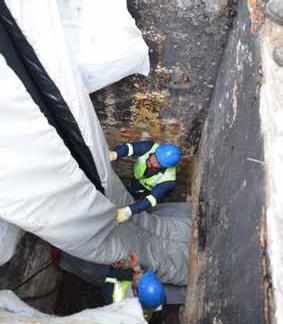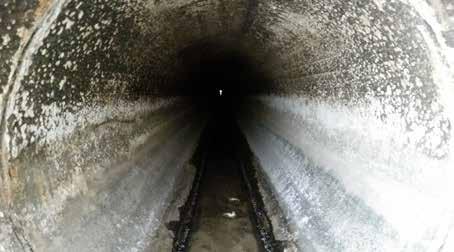
6 minute read
Trenchless Technologies
from IMIESA April 2021
by 3S Media
Sustaining the value of underground assets
Left unchecked, intensive urbanisation places increasing pressure on existing and ageing water and sewer pipeline infrastructure. Responding to the challenge requires an innovative approach that also builds construction capacity, particularly for SMMEs. Alastair Currie speaks to Neil van Rooyen, vice-president, Southern African Society for Trenchless Technology (SASTT), about trenchless solutions.
Advertisement
What are SASTT’s primary objectives in 2021?
NvR Communicating the advantages of trenchless technology (TT) has always been our primary mandate. Aside from ongoing education and training, our overall objective is to establish an enabling TT framework that serves as the benchmark for informed decisions across the public and private sector.
This includes ensuring the appropriate standards and specifications are in place from a contracting and procurement perspective. At present, specifications have been written for slip lining of pipelines, pipe bursting and horizontal directional drilling, and we’re busy finalising a document for cured-in-place pipe (CIPP) lining specifications. We’ve also recently completed a draft for CCTV specifications.
Overall, we must ensure that there is a unified understanding and appreciation of the benefits of TT as a holistic solution, with a major emphasis on promoting those ideally suited for South African conditions and our infrastructure priorities.
Installation of liner in Blackmac Sewer
What’s the significance of being part of the broader International Society for Trenchless Technology?

It’s very important because it enables us to learn and apply international best practices. In developed countries, the focus is on efficiencies, so they readily embrace TT because it makes financial sense. Commercial activities cannot be constrained because of disruptive construction activities – e.g. open-cut trenching across a major traffic intersection or business node.
Classic TT examples for new installations and upgrades include horizontal directional drilling, pipe jacking, micro tunnelling, pipe bursting, CIPP and slip lining. Running in parallel are invaluable asset management tools for critical aspects like in situ pipeline inspection (water and sewer) and leak detection.
As with choosing any construction technology, it’s about economies of scale. That’s also interdependent on having the best information.
Has the Covid-19 cost-cutting environment made TT too expensive?
No, this is not the case, since TT has been proven to be faster and more cost-efficient in its purpose-designed application – i.e. urban environments and complex infrastructure projects like underground pipeline river crossings.
But before any technology debate should be engaged, we first need to answer a universal question: can we afford to carry on with a ‘business as usual’ approach? The answer is an overwhelming no. If we do, then we are unlikely to meet our National Development Plan (NDP) 2030 targets.
The advent of Covid-19 is the reset button worldwide for a fresh approach to key issues like smart city evolution and sustainable habitation in general. Historically, TT has always been part of the response, but now it’s an indispensable part of the solution.
Cape Flats 3 Bulk Sewer – Phase 2: positioning the jacking frame within the jacking shaft (Photo credit: Terry February)
Do municipalities have a clear understanding of where TT can be employed?
Early adopters and TT pioneers like the City of Cape Town have certainly proven the benefits on a wide range of water and sewer pipeline projects. Their leadership approach has subsequently filtered through to other Western Cape municipalities like Drakenstein, Overstrand and Stellenbosch.
However, across the board, we generally find municipalities have not adopted TT because it’s not well defined in their existing toolbox. Many municipalities and public sector entities also still tend to view TT as a single methodology.
From SASTT’s perspective, we need to ensure that there is a clear understanding that TT is multifaceted and scalable. TT is also an indispensable way for municipalities and utilities to obtain accurate infrastructure condition
assessment reports using CCTV cameras to inspect pipeline networks.
When municipalities understand the scale of the problem, they have a plan of action. Otherwise, they’re severely constrained.
Can you prove the business case for TT versus open-cut trenching?
Statistically, it’s been proved that TT is around 30% more efficient compared to open-cut trenching in urban environments worldwide. Open-cut projects, for example, are yellow metal intensive, with their associated diesel fuel burn costs. They also have higher costs associated with major earthworks and the re-establishment of infrastructure like asphalt overlays. In contrast, TT is greener and cleaner.
Of course, there will always be scenarios where open-cut trenching is more costeffective. Examples include rural areas, greenfield developments where there’s no existing infrastructure in place, and pipeline replacement projects where there is too much existing congestion in terms of old networks.
Another example would be where the displacement caused by an upgraded pipeline is too large, ruling out a TT pipe bursting Our role as SASTT is to provide SMMEs with the requisite knowledge. Through our membership base, prospective SMMEs also have access to a comprehensive range of TT original equipment manufacturers and suppliers. There are also potential subcontractor opportunities.
Depending on the TT technique applied, barriers to entry are relatively low. For example, an SMME could start by providing a camera inspection service. From there, the business could progress to CIPP projects, and then eventually to more complex pipe installations.
WHAT IS TRENCHLESS TECHNOLOGY?
Trenchless technology is a type of subsurface construction work that requires few trenches or no continuous trenches. It is a rapidly growing sector of the construction and civil engineering industry. It can be defined as “a family of methods, materials, and equipment capable of being used for the installation of new or replacement or rehabilitation of existing underground infrastructure with minimal disruption to surface traffic, business, and other activities”. (Source: SASTT)
approach, say where the required pipeline size of the new installation is more than 1.5 times the diameter of the existing pipeline.
Is there space for SMMEs to enter the TT market?
This is one of SASTT’s major objectives for 2021 and beyond. We are committed to creating a platform where we can attract new entrants, especially SMMEs. However, it’s a ‘chicken and egg’ scenario, since construction sector recovery and growth depend on how soon government can ramp up its infrastructure investments.
Before CIPP refurbishment on a section of the Blackmac Sewer

After installation of the CIPP liner
Which TT solutions are currently the most appropriate?

It depends on whether municipalities and utilities take a proactive or reactive stance. For proactive municipalities, the most important TT tools to deploy immediately are those that highlight the size of the problem. Examples would include pipeline inspection and leak detection under live flow conditions, using data loggers to determine flow compared against billable revenues. Waterloss management is the immediate priority, followed by sewer line system integrity.
A reactive approach is never recommended; however, where emergency work is needed, TT methods are ideally suited for remediation work.
A more proactive approach, though, is always beneficial, as the asset owner can take advantage of economies of scale by understanding the size and scale of the network problem. This allows for adequate budgeting, forecasting, and resourcing of suppliers and contractors.
It’s a race against time to meet the NDP 2030 objectives. What needs to change?
As an industry, we need a clear and implementable roadmap from government. Infrastructure is failing and service delivery protests are on the rise. The health, safety and well-being of communities are also being compromised.
The end game of infrastructure projects is to create and maintain services that enable sustained socio-economic growth. TT can play a core part in this process by installing, restoring and upgrading water and sewer pipeline networks across South Africa. In the process, this includes helping to establish an emerging SMME base that can transition into tomorrow’s top-tier contractors.










